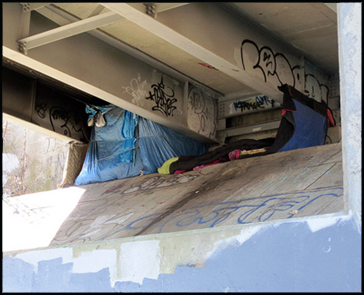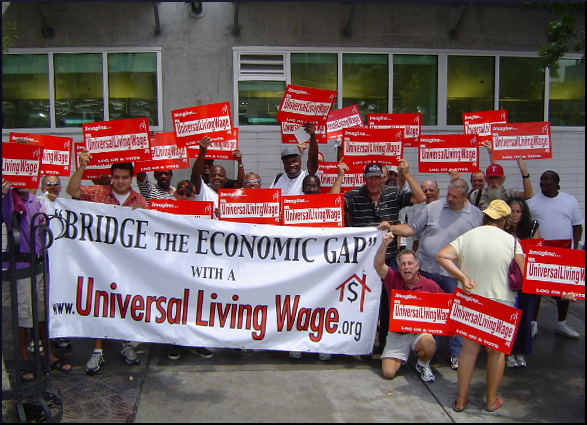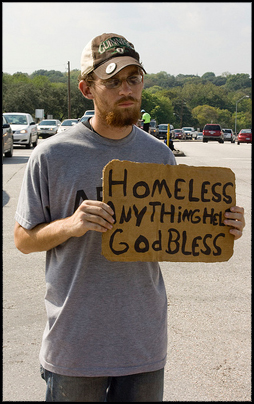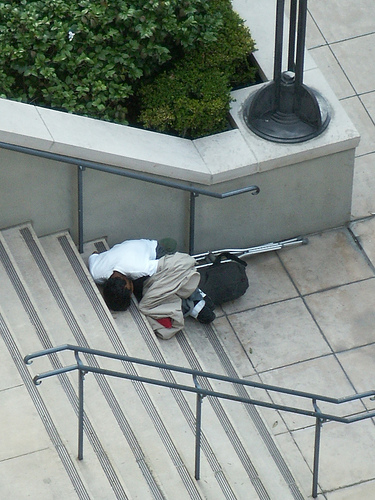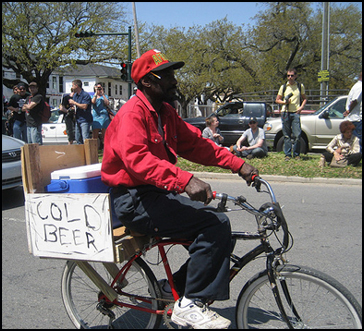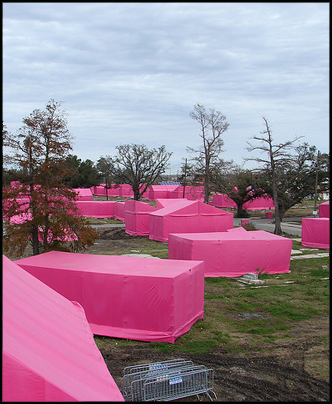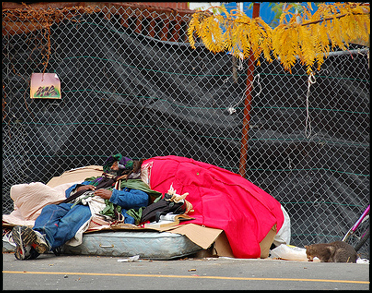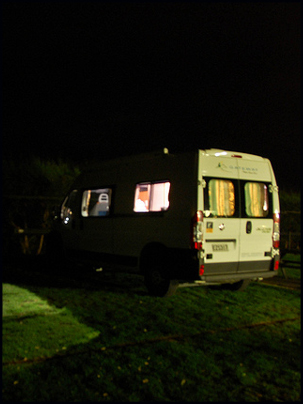
Economic homelessness is an important concept in the overall picture examined in Looking Up At the Bottom Line. The economic homeless are the working poor who have some kind of a job, but nothing close to a living wage that would provide, for instance, rent. They inhabit cars, shelters, squats, friends’ couches, and other temporary and very marginal quarters. Or no quarters at all.
An interesting thing happened when New York State was electing itself a new governor last fall. Jimmy McMillan, representing a political party called The Rent Is Too Damn High, participated in the televised debate, and his remarks are worth listening to. This video clip gives the gist, in under two minutes. The candidate did not succeed in the gubernatorial election, but that’s okay, because it frees him up to concentrate on his 2012 presidential campaign.
Suzanne Rozdeba conducted an interview with McMillan for the East Village local edition of The New York Times. At one point, the candidate underwent a spell of homelessness himself. The entire interview is highly recommended, and Rozdeba must be profusely thanked for capturing a number of excellent quotations from Jimmy McMillan. Here are just a few:
*Market value is a bunch of crap. It’s a plan to run out the poor.
*You’ve got to stop paying people in the government a football player salary.
*I would have no problem getting any bill passed before the House and the Senate.
*I guarantee you, if I’m sworn in in January, jobs will pop up in February.
*Whatever party I run under, I want them to know I’m not satisfied with anything coming from any elected official.
*We have bird-brained economic leaders. People need money to spend. And it boils down to one thing: the rent is too damn high.
Is McMillan just a freakshow? Maybe not. He was written up in the Wall Street Journal. For a very different establishment, the Center for a Stateless Society, Kevin Carson considered the ideas held by the very entertaining politician, and compared them with the ideas of Franz Oppenheimer. Here, roughly, is the argument, and it has a lot to do with homelessness. Economic exploitation, of course, goes way back. Carson says,
In sparsely populated areas of the New World, the state preempted ownership of vacant land, barred access to ordinary homesteaders, and then granted title to favored land barons and speculators. The result is that we see enormous tracts of vacant and unimproved land held out of use by state-privileged landlords, so that land is made artificially scarce and expensive for those who desire an opportunity to support themselves.
This artificial scarcity exists because the state wrongfully enforces artificial property rights. Of course, the first thing you want to ask is, what’s the difference between an artificial property right and a genuine property right? Capitalism creates artificial private property rights by coercion, backing up the right of a privileged few who control access to natural opportunities. Genuine, legitimate private property, by contrast, is about the right to possess the fruits of one’s own labor, for instance by growing a crop on land that nobody is using. Carson says,
[… T]he privileged classes of landlords, usurers and other extortionists seek to close off opportunities for self-employment because such opportunities make it too hard to get people to work for them on profitable terms. [… T]he artificial dearth of natural opportunities to produce creates a buyer’s market for labor in which workers compete for jobs instead of jobs competing for workers.
When everything is owned by the government plus a lucky few people at the top, the vast majority of the people can’t be self-sufficient, because they have no resources to work with. Which makes them sitting ducks, ripe for economic exploitation. For instance, they wind up paying a grotesque percentage of their income just on rent — or are totally unable to afford even the lowest available rent.
Which brings us back to Jimmy McMillan, a voice of sanity crying out in the wilderness. It puts him in the same realm as Richard R. Troxell of House the Homeless. We very much recommend the excellent radio interview (with host Wayne Hurlbert), during which Richard talks how the Universal Living Wage is good for business, and how it can get a million minimum-wage workers off the streets, while preventing economic homelessness for 10 million minimum-wage Americans.
In many cases, those with mental illness or substance abuse problems, or both, fall into the chronically homeless category. A lot of the “chronically homeless” are just plain unfit for the work force. But mental illness can be treated with conscientious medication, followup, and luck. Substance abuse can be treated with 12-step programs and other modalities. People experiencing either condition, or both, can find their way back to being productive members of the work force if there are jobs for them. They can escape the homeless condition, if there are places for them to live within the means provided by those jobs.
Those are two very big “ifs,” as Richard discovered in the late 1990s. He was working with people experiencing homelessness who had two major things going on — mental illness and substance abuse. With great struggle, he secured funding to put 20 people through a “continuum of care” program including detox, substance abuse counseling, housing, job training, and job placement. Despite the reported 100% trainee placement rate, they all ended up homeless within two years, unable to make rent with their minimum-wage paychecks.
“Substance abuse” is an interesting shorthand term. Richard expresses the same idea in different words, as “self-medicating with some memory deadening substance.” There is a valuable clue here, to the whole skid-row, lowest-common-denominator drug culture. There is a question that needs to be asked: What is it about life in contemporary America that makes so many people want to deaden their memories? When we confront that question, we will be ready to make some progress.
Reactions?
Source: “Looking Up at the Bottom Line,” Amazon.com
Source: “The Rent Is Too Damn High Party’s Jimmy McMillan at the NY Governor Debate,” YouTube.com
Source: “Interview | Jimmy McMillan,” The Local East Village NYT, 01/18/11
Source: “Yes — The Rent Really Is Too Damn High!,” c4ss.org,10/26/10
Screen capture of Jimmy McMillan is used under Fair Use: Reporting.

